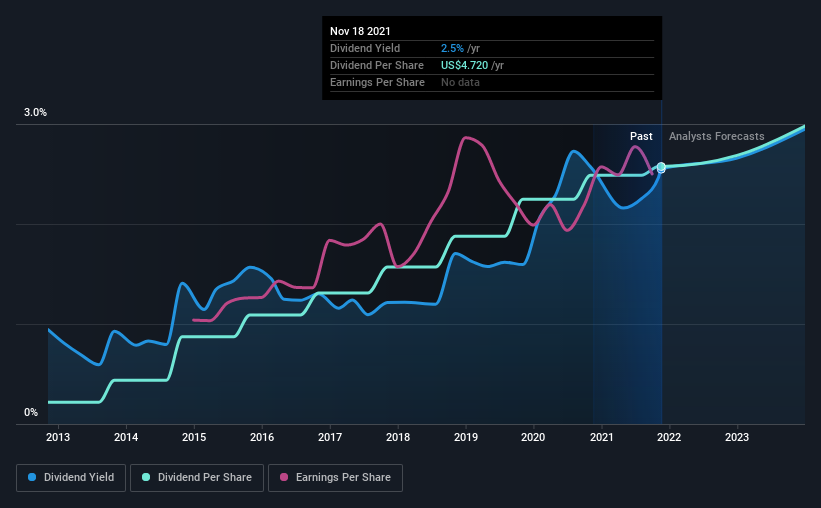Why You Might Be Interested In Huntington Ingalls Industries, Inc. (NYSE:HII) For Its Upcoming Dividend
Readers hoping to buy Huntington Ingalls Industries, Inc. (NYSE:HII) for its dividend will need to make their move shortly, as the stock is about to trade ex-dividend. The ex-dividend date is usually set to be one business day before the record date which is the cut-off date on which you must be present on the company's books as a shareholder in order to receive the dividend. It is important to be aware of the ex-dividend date because any trade on the stock needs to have been settled on or before the record date. Thus, you can purchase Huntington Ingalls Industries' shares before the 24th of November in order to receive the dividend, which the company will pay on the 10th of December.
The company's next dividend payment will be US$1.18 per share. Last year, in total, the company distributed US$4.72 to shareholders. Based on the last year's worth of payments, Huntington Ingalls Industries has a trailing yield of 2.5% on the current stock price of $185.19. If you buy this business for its dividend, you should have an idea of whether Huntington Ingalls Industries's dividend is reliable and sustainable. So we need to investigate whether Huntington Ingalls Industries can afford its dividend, and if the dividend could grow.
Check out our latest analysis for Huntington Ingalls Industries
If a company pays out more in dividends than it earned, then the dividend might become unsustainable - hardly an ideal situation. Huntington Ingalls Industries paid out a comfortable 27% of its profit last year. A useful secondary check can be to evaluate whether Huntington Ingalls Industries generated enough free cash flow to afford its dividend. It paid out 25% of its free cash flow as dividends last year, which is conservatively low.
It's encouraging to see that the dividend is covered by both profit and cash flow. This generally suggests the dividend is sustainable, as long as earnings don't drop precipitously.
Click here to see the company's payout ratio, plus analyst estimates of its future dividends.
Have Earnings And Dividends Been Growing?
Companies with consistently growing earnings per share generally make the best dividend stocks, as they usually find it easier to grow dividends per share. If earnings decline and the company is forced to cut its dividend, investors could watch the value of their investment go up in smoke. For this reason, we're glad to see Huntington Ingalls Industries's earnings per share have risen 15% per annum over the last five years. Earnings per share are growing rapidly and the company is keeping more than half of its earnings within the business; an attractive combination which could suggest the company is focused on reinvesting to grow earnings further. Fast-growing businesses that are reinvesting heavily are enticing from a dividend perspective, especially since they can often increase the payout ratio later.
Many investors will assess a company's dividend performance by evaluating how much the dividend payments have changed over time. Huntington Ingalls Industries has delivered 32% dividend growth per year on average over the past nine years. Both per-share earnings and dividends have both been growing rapidly in recent times, which is great to see.
To Sum It Up
Has Huntington Ingalls Industries got what it takes to maintain its dividend payments? Huntington Ingalls Industries has been growing earnings at a rapid rate, and has a conservatively low payout ratio, implying that it is reinvesting heavily in its business; a sterling combination. It's a promising combination that should mark this company worthy of closer attention.
On that note, you'll want to research what risks Huntington Ingalls Industries is facing. Case in point: We've spotted 3 warning signs for Huntington Ingalls Industries you should be aware of.
A common investment mistake is buying the first interesting stock you see. Here you can find a list of promising dividend stocks with a greater than 2% yield and an upcoming dividend.
This article by Simply Wall St is general in nature. We provide commentary based on historical data and analyst forecasts only using an unbiased methodology and our articles are not intended to be financial advice. It does not constitute a recommendation to buy or sell any stock, and does not take account of your objectives, or your financial situation. We aim to bring you long-term focused analysis driven by fundamental data. Note that our analysis may not factor in the latest price-sensitive company announcements or qualitative material. Simply Wall St has no position in any stocks mentioned.
Have feedback on this article? Concerned about the content? Get in touch with us directly. Alternatively, email editorial-team (at) simplywallst.com.

